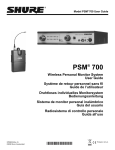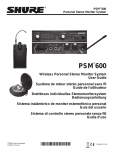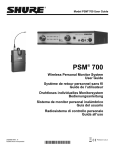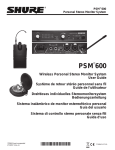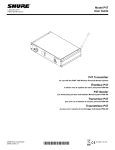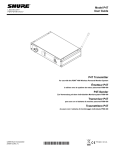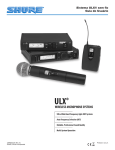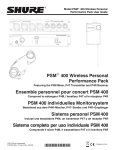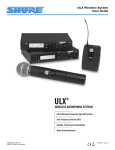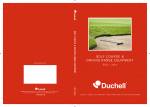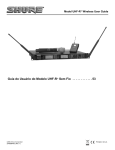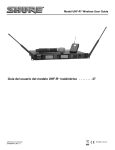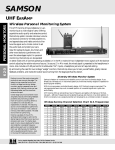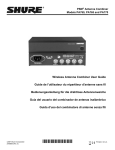Download Shure PSM700 User Guide (English)
Transcript
Model PSM® 700 User Guide PSM® 700 Wireless Personal Monitor System User Guide Système de retour personnel sans fil Guide de l’utilisateur Drahtloses individuelles Monitorsystem Bedienungsanleitung Sistema de monitor personal inalámbrico Guía del usuario Radiosistema di controllo personale Guida all’uso 27E8659 (Rev. 5) ©2008 Shure Incorporated Printed in U.S.A. This symbol indicates that dangerous voltage constituting a risk of electric shock is present within this unit. This symbol indicates that there are important operating and maintenance instructions in the literature accompanying this unit. WARNING! USING THIS SYSTEM AT EXCESSIVE VOLUMES CAN CAUSE PERMANENT HEARING DAMAGE. USE AS LOW A VOLUME AS POSSIBLE. In order to use this system safely, avoid prolonged listening at excessive sound pressure levels. Please use the following guidelines established by the Occupational Safety Health Administration (OSHA) on maximum time exposure to sound pressure levels before hearing damage occurs. 90 dB SPL at 8 hours 95 dB SPL at 4 hours 100 dB SPL at 2 hours 105 dB SPL at 1 hour 110 dB SPL at ½ hour 115 dB SPL at 15 minutes 120 dB SPL — avoid or damage may occur It is difficult to measure the exact Sound Pressure Levels (SPL) present at the eardrum in live applications. In addition to the volume setting on the PSM, the SPL in the ear is affected by ambient sound from floor wedges or other devices. The isolation provided by the fit of quality earpieces is also an important factor in determining the SPL. Here are some general tips to follow in the use of this product to protect your ears from damage. • Turn up the volume control only far enough to hear properly. • Ringing in the ears may indicate that the gain levels are too high. Try lowering the gain levels. Have your ears checked by an audiologist on a regular basis. If you experience wax buildup in your ears, stop using the system until an audiologist has examined your ears. • Wipe the ear molds with an antiseptic before and after use to avoid infections. Stop using the earphones if they are causing great discomfort or infection. ! IMPORTANT SAFETY INSTRUCTIONS ! 1. 2. 3. 4. 5. 6. 7. 8. 9. 10. 11. READ these instructions. KEEP these instructions. HEED all warnings. FOLLOW all instructions. DO NOT use this apparatus near water. CLEAN ONLY with dry cloth. DO NOT block any ventilation openings. Install in accordance with the manufacturer's instructions. DO NOT install near any heat sources such as radiators, heat registers, stoves, or other apparatus (including amplifiers) that produce heat. DO NOT defeat the safety purpose of the polarized or grounding-type plug. A polarized plug has two blades with one wider than the other. A grounding type plug has two blades and a third grounding prong. The wider blade or the third prong are provided for your safety. If the provided plug does not fit into your outlet, consult an electrician for replacement of the obsolete outlet. PROTECT the power cord from being walked on or pinched, particularly at plugs, convenience receptacles, and the point where they exit from the apparatus. ONLY USE attachments/accessories specified by the manufacturer. 12. USE only with a cart, stand, tripod, bracket, or table specified by the manufacturer, or sold with the apparatus. When a cart is used, use caution when moving the cart/apparatus combination to avoid injury from tip-over. 13. UNPLUG this apparatus during lightning storms or when unused for long periods of time. REFER all servicing to qualified service personnel. Servicing is required when the apparatus has been damaged in any way, such as power-supply cord or plug is damaged, liquid has been spilled or objects have fallen into the apparatus, the apparatus has been exposed to rain or moisture, does not operate normally, or has been dropped. DO NOT expose the apparatus to dripping and splashing. DO NOT put objects filled with liquids, such as vases, on the apparatus. The MAINS plug or an appliance coupler shall remain readily operable. The airborne noise of the apparatus does not exceed 70dB (A). Apparatus with CLASS I construction shall be connected to a MAINS socket outlet with a protective earthing connection. To reduce the risk of fire or electric shock, do not expose this apparatus to rain or moisture. Do not attempt to modify this product. Doing so could result in personal injury and/or product failure. 14. 15. 16. 17. 18. 19. 20. Quickstart P7T Transmitter Setup Ñ 3. 1. Connect the transmitter to a power outlet using the supplied power cord. NOTE: Keep wall plug or rear power cord connection readily accessible. To completely remove power to the unit, unplug from wall or detachable rear power cord connection. 1. 2. 2. Attach the supplied antenna to the ANTENNA OUT BNC connector. 3. Connect an audio source, such as a mixer, to the audio inputs of the transmitter. You can use both input jacks or choose either one for a mono source. NOTE: All inputs are phantom power protected up to 60 VDC. 4. Set the PAD switch to either +4 dB or –10 dB depending on the signal level from the audio source. 4. 5. Turn on the transmitter. 6. Set the SOURCE switch to MONO if you are using only one input. Otherwise set it to STEREO/MixMode. 7. Set the GROUP switch UP to group 1. 8. Set the CHANNEL dial to an unused channel. NOTE: See Selecting Channels. 8. 6. 9. 7. 5. 9. Power on the audio source and adjust the level control until the LEDs are in the –3 dB to +3 dB range. P7R Receiver Setup 10. Attach the antenna to the ANTENNA connector. Use the red dot to align the threads. 10. 11. Insert a 9V alkaline battery. 15. 16. 12. Set the DIP switches (See Dip Switches) 13. Set the channel to the same one as the transmitter. 14. Set the balance control to the center detent position. 15. Plug in the earphones and insert the earphones into your ears. 16. Turn the receiver on by rotating the volume dial clockwise past the click. NOTE: If you do not hear anything, check the RF LED on the transmitter to make sure it is receiving the radio signal from the transmitter. 14. 13. 12. 11. Refer to the Troubleshooting section of this manual if you encounter any problems. LOWER THE VOLUME before troubleshooting the problem. English - 1 Components P7T Transmitter with rack-mounting hardware and detachable PA715 antenna P7R Body-Pack Receiver with detachable PA710 antenna SCL3 or SCL5 Earphones with foam and flex-tip inserts Features • UHF operation. • Stereo or MixMode™ control for custom monitor mixes. • 32 user-selectable frequencies per system. • Up to 16 compatible frequencies for 16 different mixes. • Frequency compatible with all Shure Wireless systems (country dependent). • MPX Stereo audio transmission. • Switchable high-frequency boost on P7R. • +4 dBu and –10 dBV input level select switch on P7T. • Electronically balanced, combined 1/4-in. and XLR connectors on P7T can be used with balanced or unbalanced outputs. • Volume and Balance dials on the P7R Receiver. 2 - English • Internal linear power supply on P7T, switchable between 120 VAC and 230 VAC. • Peak transmitter modulation limiter with fixed threshold and modulation limit indicators. • Loop out connectors on P7T for multiple mix setups and easy installation. • Tone-Key squelch. • Half-rack chassis on P7T complete with mounting hardware. • All metal construction on P7T and P7R. • Headphone monitor on P7T for local listening. • Earphones reduce ambient sound levels by sealing off the ear canal Controls and Connectors P7T Transmitter Front Panel Input Control (INPUT). Controls the input level to the transmitter modulator. For optimum sound quality, adjust this control to keep the INPUT meter in the –3 dB to +3 dB range. Stereo Input Meters. Indicates the modulation level of the radio signal. Important: When the LIM (limit) LEDs illuminates, the system is overdriven. Reduce the input level. SOURCE Switch. Set the SOURCE switch to MONO if you are using only one input. Otherwise, set it to STEREO/MixMode. Earphone Volume Control (VOLUME). Adjusts the volume at the transmitter’s earphone connector. This control does not affect the sound level at the receiver. Earphone Connectors: 1/4 in phone and 3,5 mm (1/8 in) mini. Left=tip, right=ring, ground=sleeve. Note that only one of these outputs can be used at a time. Channel Select Control (CHANNEL). See Selecting Channels. Channel Group Switch (GROUP). See Selecting Channels. Power Button (POWER). Rear Panel Power Connector and Fuse. Connect the transmitter to a power outlet using the supplied power cord. The fuse is located in the bottom drawer. LOOP OUT Connectors — 1/4 in phone, balanced. See the LOOP Applications section of this manual. INPUT PAD Switch. Set the PAD switch to either +4 dB or –10 dB depending on the signal level of the audio source you are connecting to the transmitter’s inputs. (Refer to the output specifications for the audio source.) Input Connectors (LEFT/CH. 1 and RIGHT/CH. 2). Connect to balanced or unbalanced outputs. Accepts both 1/4-inch phone or male XLR connectors. Either connector can be used for mono input. Antenna Connector (ANTENNA OUT). 50 Ω, BNC connenctor. Attach the supplied antenna, or, if you are rackmounting the transmitter, see Front Mounting the Antenna. English - 3 P7R Receiver Balance Control. In stereo mode, this controls the left/right balance. In MixMode™, it controls the relative level of the two transmitter inputs. Earphone Connector. 3,5 mm (1/8-in.) phone jack connects to the earphones. Left=tip, right=ring, ground=sleeve. Low Battery LED (LOW BATT). Illuminates when the battery has approximately 45 minutes of operating time remaining, depending on the volume. Power LED (PWR ON). Illuminates when the power is ON and the battery is good. Power Switch and Volume Control (VOLUME). Antenna and Connector. Attach the antenna to the antenna connector. Use the red dot to align the threads. RF Signal LED (RF ON). Illuminates when the P7R is receiving a signal from the transmitter. Battery Compartment. Accepts one 9-volt battery. Open the door by pressing the latches on both sides and pulling. DIP Switches. See DIP Switches or the label on the inside cover of the battery door. Channel Selector. See Selecting Channels. Reversible Belt Clip. Belt clip can be removed and installed in the reverse position so the antenna points down when the body-pack is worn. DIP Switches 1—Channel Group Group 1 3—Equalization High Boost (Offers more high-end response: 6 dB boost at 10 kHz) Group 2 Normal (Flat) 2—Balance Control MixMode Stereo 4—Limiter On Off IMPORTANT: The limiter responds to unexpected signal peaks. It does not prevent long-term exposure to high SPL levels. This limiter is optimized for Shure E-Series earphones. The maximum limited SPL may be different for other earphones. Do not switch the limiter off unless you are using an external limiter. 4 - English Selecting Channels The PSM700 system offers a total of 32 channels. These are split into two groups: Group 1 (channels 1–16) and Group 2 (channels 17–32). Change channels if you encounter interference or need to operate more than one system at a time. • The transmitter and receiver must be set to the same group and channel. • Multiple systems must use different channels. • Use the supplied screwdriver to rotate the channel control. Channel Group Channel Group Channel Scan Mode If you have difficulty finding a clear channel, use the receiver’s Channel Scan Mode. Normally, the receiver mutes if it does not detect a signal from the transmitter. In this mode, the receiver remains unmuted, so you can listen for interference. 1. Turn off all PSM700 transmitters (leave other wireless systems on). 2. Set the receiver to group 1 (DIP switch 1 UP) and channel 1 (rotary channel select). 3. Lower the volume on the receiver to a minimal level and insert the earphones. 4. Turn on the receiver and, within 5 seconds of power up, flip DIP switch 1 down and up again. 5. Listen to all the channels in groups 1 and 2: • Clear channels will produce pure, uninterrupted white noise. • Any noises like clicks or buzzes indicate interference from another device. 6. Turn the receiver off and on again to return to normal operating mode. Select the channel with the least interference. Monitoring the Performers’ Mixes When setting up multiple systems, use an extra receiver to check and monitor each transmitter. Set the group and channel controls on the extra receiver to whichever transmitter you want to monitor. If necessary, adjust the balance control to check for proper stereo or MixMode operation. Troubleshooting PROBLEM SOLUTION No sound at the Receiver • • • • • • Make sure the transmitter is plugged in and powered on. Listen to the headphone monitor on the transmitter to check the audio source input. Make sure the transmitter and receiver are set to the same channel and group. Make sure the earphone is plugged into the receiver. Make sure receiver is on and the battery is good. Make sure the receiver and transmitter antennas are correctly attached. Short Receiver Range • • • • • Make sure all antennas are fully inserted into the jacks. Maintain line-of-sight between transmitter and receiver. Try a different group and channel setting. Check for television channel interference. Make sure the PA715 antenna is not remote mounted. Receiver sounds fuzzy or distorted • • • • Make sure no other transmitters are operating on your frequency. Make sure transmitter input level is 0 dB, ±3 dB. Listen to the headphone monitor on the transmitter to check the audio source input. Try to maintain a minimum of 10 ft. between transmitter antennas and receiver when using multiple transmitters. Low audio output at the receiver earphones • Make sure transmitter input level is 0 dB, ±3 dB. If not, switch the transmitter pad to the –10 dBV position. English - 5 Operating Modes This section illustrates the three basic modes of operation. For additional installations, including those for multiple systems, see the LOOP Applications section. NOTE: Although a mixing console is shown as the audio source in the following diagrams, you can use any balanced or unbalanced outputs at LINE level (for example, CD players, DAT machines, and microphone preamplifiers). For best results, use LINE level audio signals. Stereo Use this setup when outputs 1 and 2 from the mixer are the left and right channels of a stereo mix. The left channel goes to the left earphone, and the right channel goes to the right earphone. The balance control on the receiver moves the stereo image left and right. 1. ÑÑ Ñ Ñ ÑÑ Ñ ÑÑÑÑÑ 0 4 C 3. 8 2. 1. Connect the mixer outputs to the transmitter. 2. Set the SOURCE switch on the P7T front panel to STEREO. 3. Set DIP switch 2 of the P7R Receiver to STEREO. MixMode™ Operation Use this setup when outputs 1 and 2 from the mixer are different mono mixes. Each mix goes to both earphones. The performer uses the balance control on the receiver to make one mix louder than the other. The total volume remains equal in both ears. 1. ÑÑÑ ÑÑ 2. 1 1 2 3. 1. Connect the mixer outputs to the transmitter. 2. Set the SOURCE switch on the P7T transmitter to STEREO/MixMode. 3. Set DIP switch 2 on the receiver to MixMode. 6 - English 2 Mono Use this setup when there is only one output from the mixer. Ñ 1. 2. 1. Connect the mixer to either the Left/CH.1 or Right/CH.2 input of the transmitter. 2. Set the SOURCE switch on the transmitter to MONO. NOTE: The setting of Dip switch 2 on the receiver has no effect in this setup. LOOP Applications Use the LOOP OUT L (left) and R (right) outputs to send a copy of the audio signal going into the transmitter to other devices. Shown here are a few examples of the many applications for the LOOP outputs. NOTE: The input level control and the input pad do not affect the level of the LOOP signals. Stereo for Multiple Systems Use the LOOP OUT connectors to send one stereo signal from the mixing console to multiple P7T or P6T wireless transmitters. This frees up sends on the mixing console for other uses. ÑÑ ÑÑ Set up each system for stereo control as shown in the Stereo Control section. Connect the first transmitter to the mixer. Connect the next transmitter to the first transmitter’s LOOP outputs. Form a chain using all the transmitters in your installation. English - 7 MixMode for Multiple Systems Solo Mixes Some performers need to hear more of their own voice or instrument, while others want to hear more of the band. With this setup, each performer hears a combination of the whole band and their own instrument, and they can use the receiver’s balance control to create the desired mix of the two. Band Mix ÑÑÑÑÑÑÑÑÑÑ Setup each system for MixMode. From the mixing console, send a mix of the whole band to input 2 of the first transmitter. Connect input 2 of the next transmitter to the LOOP OUT R output of the first transmitter. Continue the chain with all the transmitters. Next, create solo mixes for each performer using the auxiliary outputs of the mixing console. Send these mixes to input 1 of each performer’s transmitter. Floor Monitors Connect the LOOP OUT connectors to the amplifier for onstage loudspeakers. The P7R and the onstage monitors will have the same audio. ÑÑÑ ÑÑ ÑÑÑ ÑÑ Recording Devices To record a performance, connect the LOOP outputs to the inputs of a tape deck, DAT, or other recording device. ÑÑÑÑ ÑÑ Ñ 8 - English Specifications SYSTEM Power 9 V battery (alkaline recommended), 4–6 hours (volume dependent) Audio Output Connector 3.5 mm Stereo (Left = tip, Right = ring, Ground = sleeve) Minimum Load Impedance 16 Ω Net Weight 0.23 kg (0.52 lbs.) Overall Dimensions 27.18 mm X 64.52 mm X 85.09 mm (1.070 in X 2.540 in X 3.350 in) RF Carrier Frequency Range 524-952 MHz (Available frequencies vary, depending on applicable regulations in the country where the system is used) Operating Range 90 m (300 ft.), under optimum environmental conditions Audio Frequency Response 50 to 15k Hz (+0, –3 dB @1 kHz); earphone dependent Image Rejection 80 dB typical Spurious Rejection 80 dB typical Total Harmonic Distortion (@1 kHz) 0.8% typical (Ref. ±35 kHz deviation) Modulation FM ±35 kHz deviation (nominal), MPX Stereo Channel Separation 35 dB typical Signal-to-Noise Ratio 80 dB typical (A-weighted) Operating Temperature –7° C to +49° C (+20° F to 120° F) NOTE: Electrical safety approval is based on a maximum ambient temperature of 35°C. Battery Life 4–6 hours, volume dependent Polarity P7T audio inputs to P7R audio outputs: Non-inverting XLR: pin 2 positive with respect to pin 3 1/4 in TRS: Tip positive with respect to ring P7T TRANSMITTER RF Output Power 100 mW (+18.5 dBm) typical conducted, U.S.A. and Canada (varies with other countries) Modulation Limiter Internal peak limiter (>10:1 compression) Antenna External whip, 50 Ω BNC connector Power Requirements P7T: 90–120 VAC, 50/60 Hz EP7T: 220–240 VAC, 50/60 Hz NOTE: This product is not disconnected from the mains power supply when the power switch is in the OFF position. Current 115 mA maximum at 120 VAC 55 mA maximum at 230 VAC Fuse P7T: 90–120 VAC, 160 mA/250 V (SLO-BLO®) EP7T: 220–240 VAC, 80 mA/250 V time delay 5mm X 20mm Dimensions 44.5 mm X 196.8 mm X 241.3 mm (1 3/4 in X 7 3/4 in X 9 1/2 in.) Net Weight 1.497 kg (3 lb, 4.8 oz.) P7R RECEIVER RF Sensitivity 0.7 µV typical Squelch Threshold 2 µV typical Antenna Input Impedance 50 Ω typical Antenna External, threaded connector P7T Audio Inputs (LEFT/CH.1 and RIGHT/CH.2) Configuration Actual Impedance Nominal Input Level Maximum Input Level Pin Assignments Phantom Power Protection? XLR Electronically Balanced 20 kΩ +4 dBu (+4 input level) –10 dBV (–10 input level) +25 dBu (+4 input level) +13 dBu (–10 input level) Pin 1 = ground Pin 2 = hot Pin 3 = cold Yes, up to 60 VDC 1/ 4-inch Phone Jack Electronically balanced 20 kΩ +4 dBu (+4 input level) –10 dBV (–10 input level) +25 dBu (+4 input level) +13 dBu (–10 input level) Tip = hot Ring = cold Sleeve = ground Yes, up to 60 VDC P7T Outputs (L/R LOOP) Configuration: Actual Impedance: Nominal Output Level: Maximum Output Level: Pin Assignments: Phantom Power Protection? Electronically Balanced 20 kΩ +4 dBu (+4 input level) –10 dBV (–10 input level) +25 dBu (+4 input level) +13 dBu (–10 input level) Tip = hot Ring = cold Sleeve = ground Yes, up to 60 VDC English - 9 Certification P7T: Certified to FCC Parts 74, FCC ID DD4P7T. DD4P7TB Certified in Canada by IC to RSS-123. UL and cUL LISTED to UL813 and CSA C22.2 No. 1. TÜV DENAN Certified to J 60065. EP7T: Meets essential requirements of European R&TTE Directive 99/5/EC, eligible to bear CE marking. Type approved to EN 300 422 Parts 1 and 2. Meets requirements of EMC Standard EN 301 489 Parts 1 and 9. VDE GS Certified to EN 60065. P7R: Approved under the Declaration of Conformity (DoC) provision of FCC Part 15. Certified in Canada by IC to RSS-123. Meets essential requirements of European Union R&TTE Directive 99/5/EC, eligible to bear CE marking. Meets requirements of EMC Standard EN 301 489 Parts 1 and 9. This Radio Equipment is intended for use IN MUSICAL PROFESSIONAL ENTERTAINMENT AND SIMILAR APPLICATIONS. NOTE: This Radio apparatus may be capable of operating on some frequencies not authorized in your region. Please contact your national authority to obtain information on authorized frequencies for wireless microphone products in your region Licensing: A ministerial license to operate this equipment may be required in certain areas. Consult your national authority for possible requirements. Shure Transmitter Model P7T may be used in the countries and frequency ranges listed in in the Appendix. FCC Statement. The P7R Receiver complies with Part 15 of the FCC rules. Operation is subject to the following two conditions: (1) this device does not cause harmful interference, and (2) this device must accept any interference received, including interference that may cause undesired operation. Licensing Statement. A user license may be required for operation. Contact the communications authority in your country for more information. Modifications to Approved Equipment. Changes or modifications not expressly approved by Shure Incorporated could affect compliance with telecommunications standards, thereby voiding the user’s authority to operate this product. Voltage Selection WARNING Voltages in this equipment are hazardous to life. No user-serviceable parts inside. Refer all servicing to qualified service personnel. The safety certifications of the P7T/EP7T do not apply when the operating voltage is changed from the factory setting. P7T and EP7T transmitters can be internally modified to operate at either 120 Vac or 230 Vac as follows: 1. Disconnect the P7T/EP7T from the AC power source. 2. Remove the eight Phillips head screws securing the top cover. 3. Locate Voltage Selector switch SW4 adjacent to power transformer T1 and, using a screwdriver, turn the center rotor to the desired position: For 120 V operation, turn it to the 115 V position. For 230 V operation, turn it to the 230V position. 4. Locate fuse and remove it. Replace it with the proper fuse: For 120 V operation, use a 160 mA, 250 V, slow-blow fuse. For 230 V operation, use a 80 mA, 250 V, time delay fuse. Fuse Part Numbers Fuse Type 80 mA, 250 V time delay 160 mA, 250 V SLO-BLO Shure Part No. 80H380 80K258 Part No. Schurter .034.3106 Littelfuse® 218.160 5. Replace the power cord with the proper power cord: For 120 V operation, use an IEC appliance connector on the equipment end and a mains connector suitable for 115 V operation on the other.* (Shure part #95A8389.) For 230 V operation, use an IEC appliance connector on the equipment end and a CEE 7/7 (“Schuko”) mains connector on the other.* (Shure part #95A8247.) * For systems requiring other mains connectors, obtain a power cord with an IEC 320 type mating connector for connection to the P7T, and an appropriate plug on the other end for connection to the mains. The supplied cord uses Harmonized IEC Cordage with color coding as follows: Brown = Line, Blue = Neutral, Green/Yellow = Ground. 10 - English Accessories Furnished Optional Body-Pack Antenna (524-750 MHz) ..................................... 90A8964 Body-Pack Antenna (770-870 MHz) ..................................... 90B8964 Transmitter Antenna (524-750 MHz) .................................... 95A8699 Transmitter Antenna (770-870 MHz) .................................... 95A8621 Rack Mount Kit .................................................................PA745 61 cm (2 ft) Coaxial Cable (RG-58/U)...................................... UA802 Bulkhead Adapter ............................................................. 95A8994 SCL3/SCL5 sleeve assortment with cleaning tool .............. 90XJ1371 Antenna Combiner ................................................... PA760 (120 VAC) ................................................... PA770 (120 VAC) ............................................PA821 (100-240 VAC) .................................................PA765E (240 VAC) .................................................PA770E (240 VAC) Unidirectional Antenna ...........................................................PA805WB 3.3 m (10 ft.) Coaxial Antenna Cable (BNC connector) ........... PA725 Bag of 20 Foam Ear Sleeves (yellow)...................................... PA750 Triple-Flange Ear Sleeves (2) .................................................. PA755 Bag of 10 Flex-Tip Ear Sleeves (small).................................. PA756S Bag of 10 Flex-Tip Ear Sleeves (medium) ............................ PA756M Bag of 10 Flex-Tip Ear Sleeves (large) .................................. PA756L PA805WB Unidirectional Antenna This unidirectional, remote-mountable, wide-band transmitting antenna provides wireless coverage in a cardioid pattern. Use the PA805WB to secure a line-of-sight transmission path from the transmitter to the receiver when the actual transmitters are obscured. Also, since the PA805WB has some gain (due to its directivity), it is useful when covering long distances. PA821, PA760, PA765, PA770 Antenna Combiners Reduce rack clutter and improve performance by combining up to four transmitters into a single antenna. These internally powered, half-rack units make transportation and setup easy, and they significantly reduce interference between transmitters by lowering the intermodulation distortion (IMD) level. Select among the different models to match the frequency range of your systems. (Please note that PA700 antenna combiners cannot be cascaded to each other.) PA760 PSM700s P6HW Hardwired Body Pack Ñ Ñ Some performers, such as drummers and keyboard players, benefit less from the on-stage mobility that wireless systems offer. For these users, hardwired monitor systems, like the Shure P6HW, offer the same features of a wireless system at a lower cost. The P6HW also includes an input pad, for increased dynamic range, and an input peak indicator to alert the user when levels are too high. SCL Earphones Shure offers a variety of earphones to fit your needs. Designed exclusively for PSM systems, they deliver superior sound quality. For the added comfort of a precise fit, custom earmolds are also available for SCL3 model earphones. English - 11 Rack Mounting WARNING: Do not torque the screws too tightly, or the chassis may be damaged. Single Unit Dual-Mounted Units IMPORTANT: Attach the link bars so the recessed horizontal holes face out and the threaded and unthreaded vertical holes align. Dual Mounting with Other Shure Products Shure P7T and P6T transmitters and SC and LX receivers can be dual-mounted interchangeably (although the front panels for different products may not align evenly). For each side, use the rack ear that came with that product. The link bars are universal. Front Mounting the Antenna When rack mounting units, use the supplied cable and bulkhead adapter to front mount the antenna. This prevents other cables from becoming entangled in the antenna and can greatly reduce RF interference. 12 - English English - 13 APPENDIX ANNEXE TABLE 1 Country Code Code de Pays Lander-Kurzel Código de País Codice del Paese P7T-H3 (524 - 554 MHz) ANHANG TABLEAU 1 P7T-L2 (632 - 662 MHz) TABELLE 1 P7T-HF (722 - 746 MHz) APENDICE TABLA 1 APPENDICE TABELLA 1 P7T-P5 (722 - 746 MHz) P7T-MN (800 - 830 MHz) P7T-KE (842 - 865 MHz) USA 524 - 554z* 632 - 662* 722 - 746* * * * CAN 524 - 554* 632 - 662* 722 - 746* * * * A 524 - 554* 632 - 662* 722 - 746* 722 - 746* 800 - 830* 842 - 865* B 524 - 554* 632 - 662* 722 - 746z* 722 - 746* 800 - 830 842 - 865* CH 524 - 554* 632 - 662* 722 - 746* 722 - 746* 800 - 830* 842 - 865* CY * * * * * * CZ 524 - 554* 632 - 662* 722 - 746* 722 - 746* 800 - 830* * 842 - 865* D 524 - 554* 632 - 662* 722 - 746* 722 - 746* 800 - 830* DK * * * * 800 - 820* 863 - 865* E 524 - 554* 632 - 662* 722 - 746z* 722 - 746* 800 - 830* 842 - 865* EST 524 - 554* 632 - 662* 722 - 746* 722 - 746* 800 - 830* 842 - 865* F * * * 722-746* * 863 - 865* FIN * * * * 800,1 - 819,9* 863 - 865* GB 524 - 554* 632 - 662z* 722 - 746z* 722 - 746* * 842 - 865* GR 524 - 554* 632 - 662* 722 - 746* 722 - 746* 800 - 830* * I 524 - 554* 632 - 662* 722 - 746* 722 - 746* * 863 - 865* H 524 - 554* 632 - 662* 722 - 746* 722 - 746* 800 - 830* * IRL 524 - 554* 632 - 662* 722 - 746* 722 - 746* 800 - 830* 842 - 865* L 524 - 554* 632 - 662* 722 - 746* 722 - 746* 800 - 830 842 - 865z* LT 524 - 554* 632 - 662* 722 - 746* 722 - 746* 800 - 830* * LV * * * * * * M 524 - 554* 632 - 662* 722 - 746* 722 - 746* * 842 - 865* N * * * * 800 - 820* 863 - 865* NL 524 - 554* 632 - 662* 722 - 746* 722 - 746* 800 - 830* 842 - 865* 842 - 865* P 524 - 554* 632 - 662* 722 - 746* 722 - 746* 800 - 830* PL 524 - 554* 632 - 662* 722 - 746* 722 - 746* 800 - 830 * S * * * * 800 - 814 * 863 - 865* SK * * * * * * SLO 524 - 554* 632 - 662* 722 - 746* 722 - 746* 800 - 830* * All Other Countries * * * * * * Tous les autres pays Alle anderen Länder Demás países Tutti gli altri Paesi *Please contact your national authority for information on available legal frequencies for your area, maximum transmitter output power, and legal use of the equipment. *Se mettre en rapport avec les autorités compétentes pour obtenir les informations sur les fréquences autorisées disponibles localement, le puissance de sortie HF de l'émetteur, et sur l'utilisation autorisée du matériel. *Für Informationen bezüglich der für Ihr Gebiet verfügbaren gesetzlich zugelassenen Frequenzen und der mösglichen Abstrahl-Leistung sowie der gesetzlichen Bestimmungen für den Einsatz der Geräte setzen Sie sich bitte mit der zuständigen örtlichen Behörde in Verbindung. *Comuníquese con la autoridad nacional para obtener información en cuanto a las frecuencias legales disponibles, la potencia RF de salida del transmisor, y usos legales del equipo en su área. *Rivolgersi alle autorità competenti per ottenere informazioni relative alle frequenze autorizzate nella propria regione, la potenza RF di uscita di trasmettitore, e alle norme che regolano l'uso di questo apparecchio. Appendix - 1 EU DECLARATION OF CONFORMITY We, of Shure Incorporated 5800 Touhy Avenue Niles, Illinois, 60714-4608 U.S.A. Phone: (847) 600-2000 Web: www.Shure.com Declare under our sole responsibility that the following product Model: P7R Description: Personal Stereo UHF Receiver conforms to the essential requirements and other relevant previsions of the R&TTE Directive (1999/5/EC). The product complies with the following product family, harmonized or national standards: EN 301 489-1 V1.4.1 (2002-08) EN 301 489-9 V1.2.1 (2002-08) EN 300 422-1 V1.2.2 (2000-08) EN 300 422-2 V1.1.1 (2000-08) The technical documentation is kept at: Shure Incorporated, Corporate Quality Engineering Division SHURE Europe GmbH, EMEA Approval Manufacturer: Shure Incorporated Signed: __________________________________ Date: 3 March 2006 Name and Title: Craig Kozokar, EMC Project Engineer, Corporate Quality Engineering Division European Representative: SHURE Europe GmbH Signed: __________________________________ Date: 3 March 2006 Name and Title: Wolfgang Bilz, Dipl. Ing. (FH), EMEA Approval SHURE Europe GmbH Headquarters Europe, Middle East & Africa Wannenäcker Str. 28 D-74078 Heilbronn, Germany Phone: +49 - (0)7131 - 7214 - 0 Fax: +49 - (0)7131 - 7214 - 14 EU DECLARATION OF CONFORMITY We, of Shure Incorporated 5800 Touhy Avenue Niles, Illinois, 60714-4608 U.S.A. Phone: (847) 600-2000 Web: www.Shure.com Declare under our sole responsibility that the following product Model: P7T Description: Personal Stereo UHF Transmitter conforms to the essential requirements and other relevant previsions of the R&TTE Directive (1999/5/EC). The product complies with the following product family, harmonized or national standards: EN 301 489-1 V1.4.1 (2002-08) EN 301 489-9 V1.2.1 (2002-08) EN 300 422-1 V1.2.2 (2000-08) EN 300 422-2 V1.1.1 (2000-08) IEC 60065:1998 EN61000-3-2:2000 Amendment A1:1998; A2:1998; A14:2000 EN 61000-3-3 Amendment A1:2001 The technical documentation is kept at: Shure Incorporated, Corporate Quality Engineering Division SHURE Europe GmbH, EMEA Approval Manufacturer: Shure Incorporated Signed: __________________________________ Date: 25 September 2007 Name and Title: Craig Kozokar, EMC Project Engineer, Corporate Quality Engineering Division European Representative: SHURE Europe GmbH Signed: __________________________________ Date: 25 September 2007 Name and Title: Wolfgang Bilz, Dipl. Ing. (FH), EMEA Approval SHURE Europe GmbH Headquarters Europe, Middle East & Africa Wannenäcker Str. 28 D-74078 Heilbronn, Germany Phone: +49 - (0)7131 - 7214 - 0 Fax: +49 - (0)7131 - 7214 - 14 ii 6+85(,QFRUSRUDWHGKWWSZZZVKXUHFRP 8QLWHG6WDWHV&DQDGD/DWLQ$PHULFD&DULEEHDQ :7RXK\$YHQXH1LOHV,/86$ 3KRQH86)D[,QW¶O)D[ (XURSH0LGGOH(DVW$IULFD 6KXUH(XURSH*PE+3KRQH)D[ $VLD3DFLILF 6KXUH$VLD/LPLWHG3KRQH)D[



















